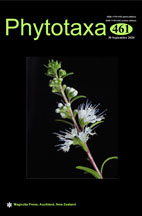Abstract
The species diversity of Callithamnion sensu lato in South Africa is re-visited using existing literature, morphology and DNA. The identity of a putative new species is confirmed as distinct using DNA and is described here as Callithamnion africanum sp. nov. Callithamnion africanum differs molecularly and morphologically from a similar species, C. cordatum with which it shares a similar habitat and distribution range in South Africa. Callithamnion africanum is resolved in the Callithamnion sensu stricto clade and is sister to the type species of the genus, Callithamnion corymbosum. Additionally, Callithamnion stuposum, a species described from South Africa and a common component of the seaweed flora, was recovered in the larger, unresolved Callithamnion sensu lato clade. An updated species inventory of Callithamnion sensu lato in South Africa is provided, and indicates a lack of sequence data for the large majority of species. Furthermore, a global rbcL phylogeny highlights a number of taxonomic concerns regarding the classification of taxa circumscribed to Callithamnion sensu lato and calls for a global revision using DNA, type specimens or material collected from near type localities.

